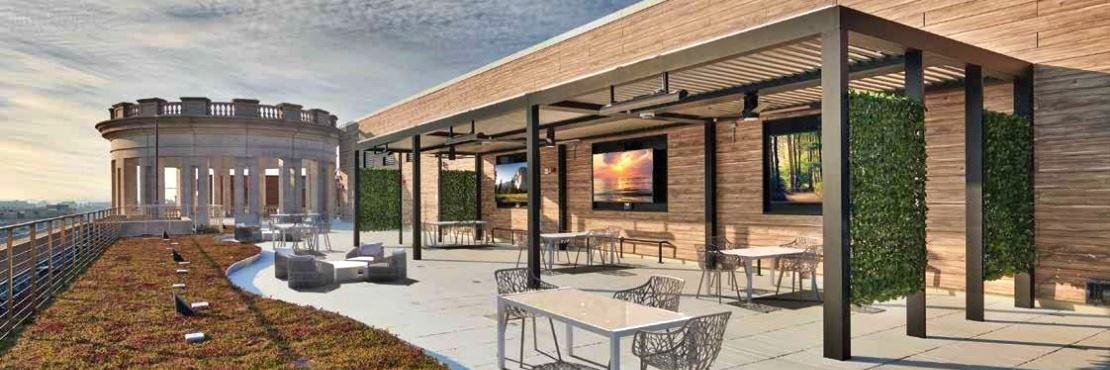
Green Roofs: Stormwater Solution and Potential Parkland
PLANTED ACREAGE IN THE D.C. METRO AREA IS INCREASING, BUT MOST OF IT IS NOT FOUND AT STREET LEVEL.
IT IS ALL ABOVE THE GROUND, ON THE GREEN ROOFS THAT ARE PROLIFERATING THROUGHOUT THE DISTRICT OF COLUMBIA AND ITS SUBURBS.
There is a good reason for this high-level, green infrastructure buildout. Over the past three decades, the District of Columbia’s rapid growth and the accompanying paving-over of pervious surfaces, led to a 34 percent increase in stormwater runoff. With sewer discharge and stormwater sharing the same large pipes in some areas, a rapid influx of water sometimes ends up sending sewage into nearby rivers.
Montgomery County and Prince George’s County in Maryland are experiencing similar strains on their stormwater systems.
“Green roof systems can capture and retain anywhere from 50 to 80 percent of the rainwater that falls on them…”
Vanessa Keitges
President and CEO of Columbia Green Technologies
To reduce that flow, D.C. adopted the Green Area Ratio Rule in 2016. It set a minimum requirement for water-retaining landscaping for every new construction and exterior renovation project on a commercial building. Since land in the District is expensive, the city allowed owners to install green roofs to meet this minimum.
“Green roof systems can capture and retain anywhere from 50 to 80 percent of the rainwater that falls on them,” explained Vanessa Keitges, president and CEO of Columbia Green Technologies, which designs and manufactures vegetative roof technologies. The other 20 to 50 percent of the rainfall is disbursed to the stormwater system over time and helps prevent flooding damage and combined sewage overflows.
The green roof is a cost-effective way for developers and owners to meet stormwater mandates. In an urban environment, a tank in the ground capable of holding that much water would take up valuable space that could be used for a basement or parking lot.
The Basics of Green Roofs
Green roofs vary in their design. They generally consist of several layers, from the bottom up, that include the deck, waterproofing, insulation, roof barrier, drainage, filter fabric, growing media and plants. Existing buildings that are being renovated may require reengineering and additional support to handle this additional load.
The growing media on a green roof is specially designed to reduce weight, ensure proper drainage and help the plants thrive in the environment. It is made from both organic and inorganic material; while it may contain soil, it often does not.
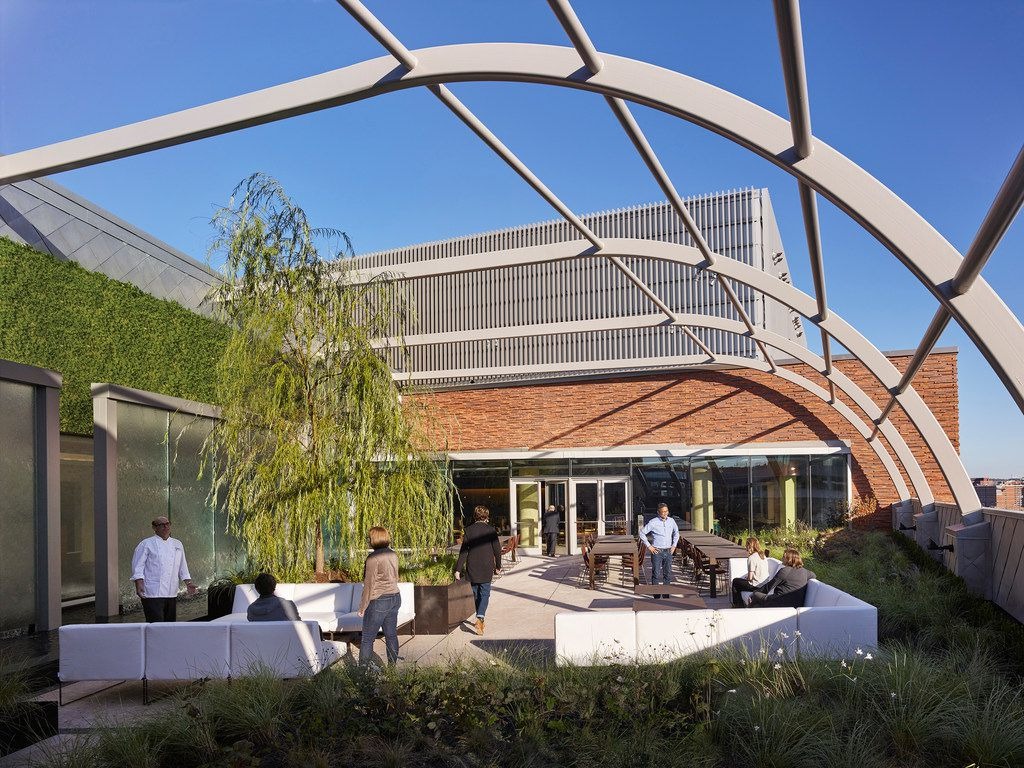
Museum of the Bible utilized both extensive and intensive roof elements.
Photo Credit: Museum of the Bible, Washington, D.C., 2016
There are two major categories of green roofs. Extensive green roofs have less-growing media, often around 3 to 4 inches deep. They add 30 to 50 pounds per square feet to the roof load and are planted with low maintenance, drought-resistant plants. Intensive green roofs have deeper substrates (up to 12 inches) and increase the roof load by anywhere from 40 to 150 pounds per square foot. They feature a variety of plants and require more maintenance, including irrigation.
Because they are less complex, extensive green roofs are much less expensive to install than intensive roofs. About 80 percent of the green roofs constructed today are extensive.
Green roofs offer many benefits beyond stormwater management/water retention. Although they cannot be used in place of roof insulation, they do provide an extra layer of protection. They help reduce energy use by keeping warm air in the building during the cold months and absorbing heat from the sun in the summer. They also provide some sound insulation.
Green roofs last longer (40-plus years) than conventional roofs because the plantings protect the roofing materials from the sun’s UV rays and from temperature extremes. The plantings also reduce CO2 and increase oxygen production.
Installation Options
Architects, landscape designers, and engineers develop the plans for green roofs, usually assisted by the material manufacturers/suppliers. The installation is done by roofing contractors and/or landscape contractors.
“Choosing a great design team, green roof system and trained green roof installers is key to a successful green roof that will be green on day one and for years to come,” said Keitges. She noted that in the D.C. market, too many green roofs have failed, which costs the owners a lot of money long term. The District of Columbia’s Department of Energy & Environment inspects green roofs after three years and fines the owners if they are not thriving.
Keitges recommends choosing a single contractor and a single green roof system for both the extensive and intensive areas of a green roof. This will ensure the work is done in accordance with all installation, specifications and warranty requirements. It keeps costs down for the general contractor and makes it easier for the owner to maintain, over time, since they will have one green roof system, one warranty and one green roof professional to call.
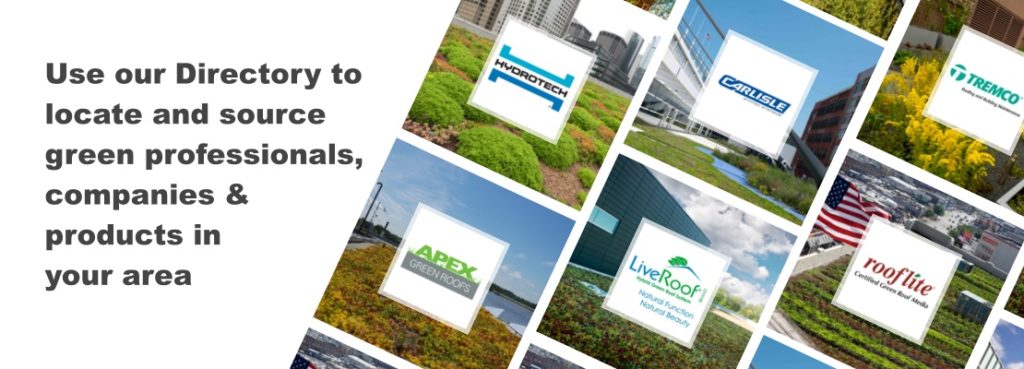
In the D.C. metro area, roofing companies today handle about 80 percent of the extensive roof work in the area, according to Dan Kauffman, commercial installation business development manager at Chapel Valley Landscape Company. “Extensive plantings are not very difficult; they are much more like putting your carpet or sod down in many cases,” he said.
Chapel Valley was a pioneer in green roofs in the metro area and has been installing them for more than 25 years. Today, the company works mainly on the more complex intensive green roof systems, which require a greater understanding of landscape design and plants.
Working on a rooftop does require added safety precautions. But otherwise, it is much like the ground-level work that Chapel Valley does, Kaufman said. “The primary difference is that we are planting into scientifically modified soils instead of planting into the ground. One of the things that we do know is how well the soil is going to work ahead of time, so there is less risk,” he said.
Getting the planting medium up to the rooftop may require the use of a blower with a hose that can reach as high as 15 stories. Other times the company has to bring both soil and plantings up to the rooftop using a crane.
The plants chosen for a green roof must be compatible with the mid-Atlantic climate and able to withstand the tough conditions on a D.C. rooftop, where temperatures can reach 110 degrees in the summer. For extensive roofs, the choice is usually sedum, which provides some color. Chapel Valley also uses drought-tolerant grasses and sedges.
To meet government requirements, extensive green roofs cannot rely on irrigation to survive once they are planted. “To gain full credit for stormwater management, temporary irrigation systems have to be removed or disabled inside of two years,” Kauffman said.
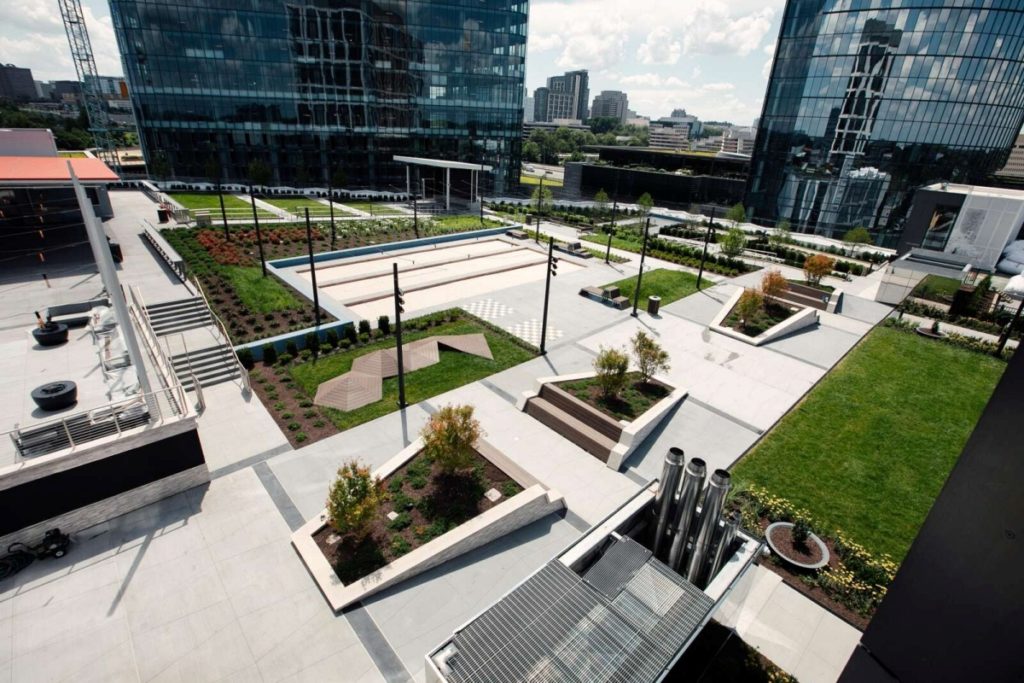
The Perch in Washington, D.C. provides a green haven, more than 10 stories above the street level.
Photo Credit: Capital One Center
He noted that the green roof materials are continuing to evolve. Chapel Valley, for example, has recently been doing more green roof biofilters. These systems replace some of the aggregate materials in the growing medium with sand to provide a better filtering system. The company is also seeing more very-thin-gauged metal walls being used as planters to contain the soil.
Although green roofs are now a proven technology, Kauffman said that some owners still have concerns about how rooftop plantings will affect their roofs over the long term. That’s one reason Chapel Valley sticks to registered green roofing systems that are backed by warranty.
When a green roof does fail, it is often not the system’s fault. Chapel Valley installed one green roof in the mid-1990s; at the time, it was the largest green roof east of the Mississippi. Twelve years later, the end user, who was performing some rooftop experiments, accidentally drove stakes into the rooftop, puncturing the waterproof membrane. As a result, the entire roof and all its plantings had to be removed before Chapel Valley could install a new green roof.
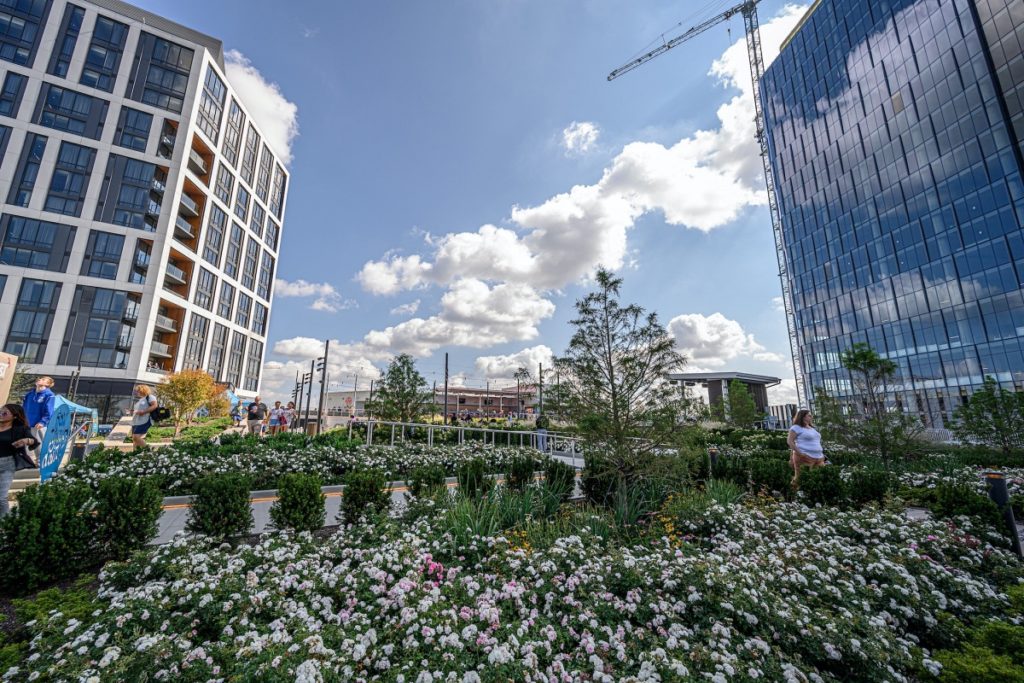
The Zen Garden at the Capital One Center creates a serene village.
Photo Credit: Capital One Center
Rebates Available for Some Green Roof Installations
There is some financial assistance available for building owners who need (or want) to install green roofs on their buildings.
The District of Columbia offers the RiverSmart Rooftops Green Roof Rebate program for residential, commercial and institutional buildings located within the Municipal Separate Storm Sewer System (MS4) area. The rebate is $15 per square foot for voluntary installation of a green roof. Grants are distributed on a first-come, first-served basis, and there is no cap on the size of projects eligible for reimbursement.
District residents, businesses and property owners who reduce stormwater runoff by installing a green roof or other green infrastructure may also be eligible for the RiverSmart Rewards program. They can earn a discount of up to 55 percent off the stormwater fee assessed by the District’s Department of Energy & Environment.
In Prince George’s County, houses, commercial businesses, multifamily dwellings and other buildings may be eligible for a rebate for installing a green roof on an existing building. The county’s Rain Check Rebate program offers a rebate to individuals, commercial businesses, multifamily dwellings and nonprofit organizations (including housing cooperatives) that install green roofs on buildings within the county. The rebate for residential and business extensive green roofs is $10 per square foot, with a limit of $4,000 for homes. For an intensive green roof, nonresidential properties only, the rebates are $20 per square foot.
Montgomery County’s RainScapes Rewards Rebates program offers a $9 per square foot rebate for green roof installations, with a maximum of $7,500 per property for residential structures and $20,000 for nonresidential.
Opening Up Green Space
Green roofs do not just solve stormwater issues. More and more — and especially since the pandemic — designers and building owners are thinking about green roofs in a different way. “They are considering how they can use green roof spaces to provide people with more access to natural air and light,” said Keitges.
The largest example of that trend is The Perch Skypark, which was built on top of the 11-story Capital One Center in Tysons, Virginia. Ruppert Landscape, Inc. did the installation, and Columbia Green provided the materials and construction support for the 2.5-acre park, which includes a beer garden, an amphitheater for musical and theatrical performances (with a giant screen for watching sporting events), a dog park, bocce ball courts, lawn areas and a sculpture garden. It is the largest rooftop park open to the public in the U.S. Other developers are following suit to help draw people back to urban areas by designing their buildings to include a park on the roof.
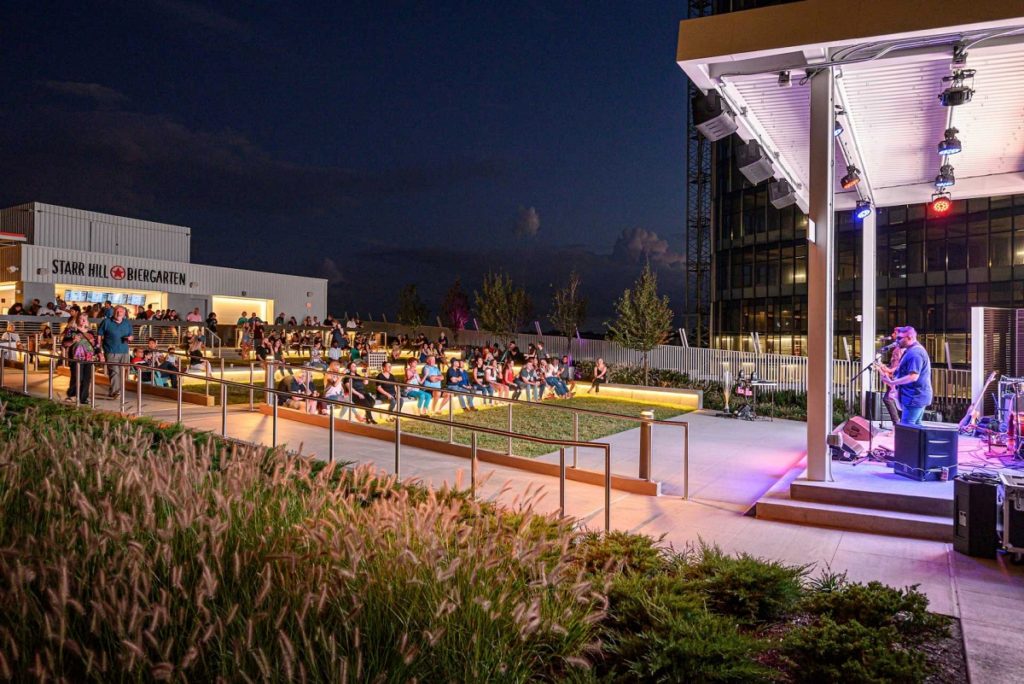
Guests at an outdoor concert at The Perch.
Photo Credit: Capital One Center
Building owners do not have to install a lavish green rooftop park to make a difference in the overall environment. One example is Sibley Memorial Hospital in D.C., which recently added an extensive green roof from Columbia Green on top of its surgical center. This 8,000-square-foot area retains more than 105,000 gallons of rainwater annually, and both the patients and the doctors enjoy looking over it.
“Research shows that such green spaces in hospitals bring many physical and mental benefits,” said Keitges. Just looking at natural elements can lower a patient’s blood pressure, reduce heart rate, lessen the need for pain medication and decrease the number of minor postoperative complications.
Since stormwater remediation will remain a primary objective of urban governments for many years, green roofs will continue to sprout up across the D.C. market. Their designs will change as designers develop new technologies and new uses for them. In the future, the green space atop a 20-story apartment complex or office building could also be used for urban agriculture, fulfilling the dual purpose of alleviating stormwater runoff while supplying fresh produce to city residents.
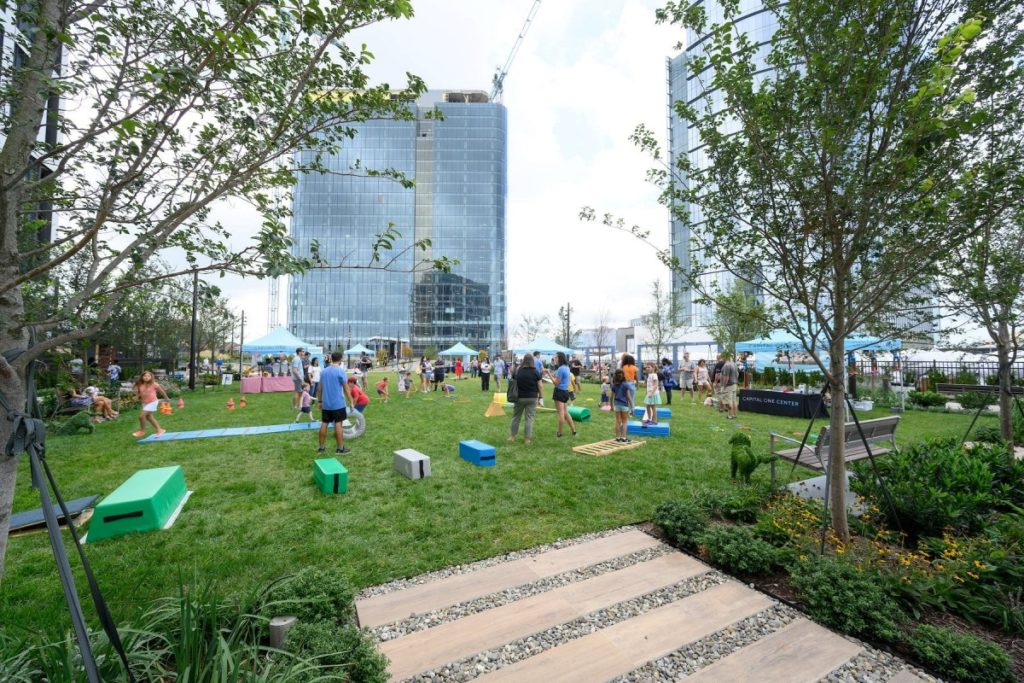
Children enjoying a party at The Perch at Capital One Center.
Photo Credit: Capital One Center
~ Mary Lou Jay

Mary Lou Jay is an experienced freelance writer/editor with expertise in feature articles, marketing and public relations materials, web-related content and more. Her goal is simple: to provide the writing and editing support that associations, businesses and other clients need for projects of every size.
Reprinted courtesy of Associated Builders and Contractors of Metro Washington. Copyright Building Washington magazine, Winter 2021.
